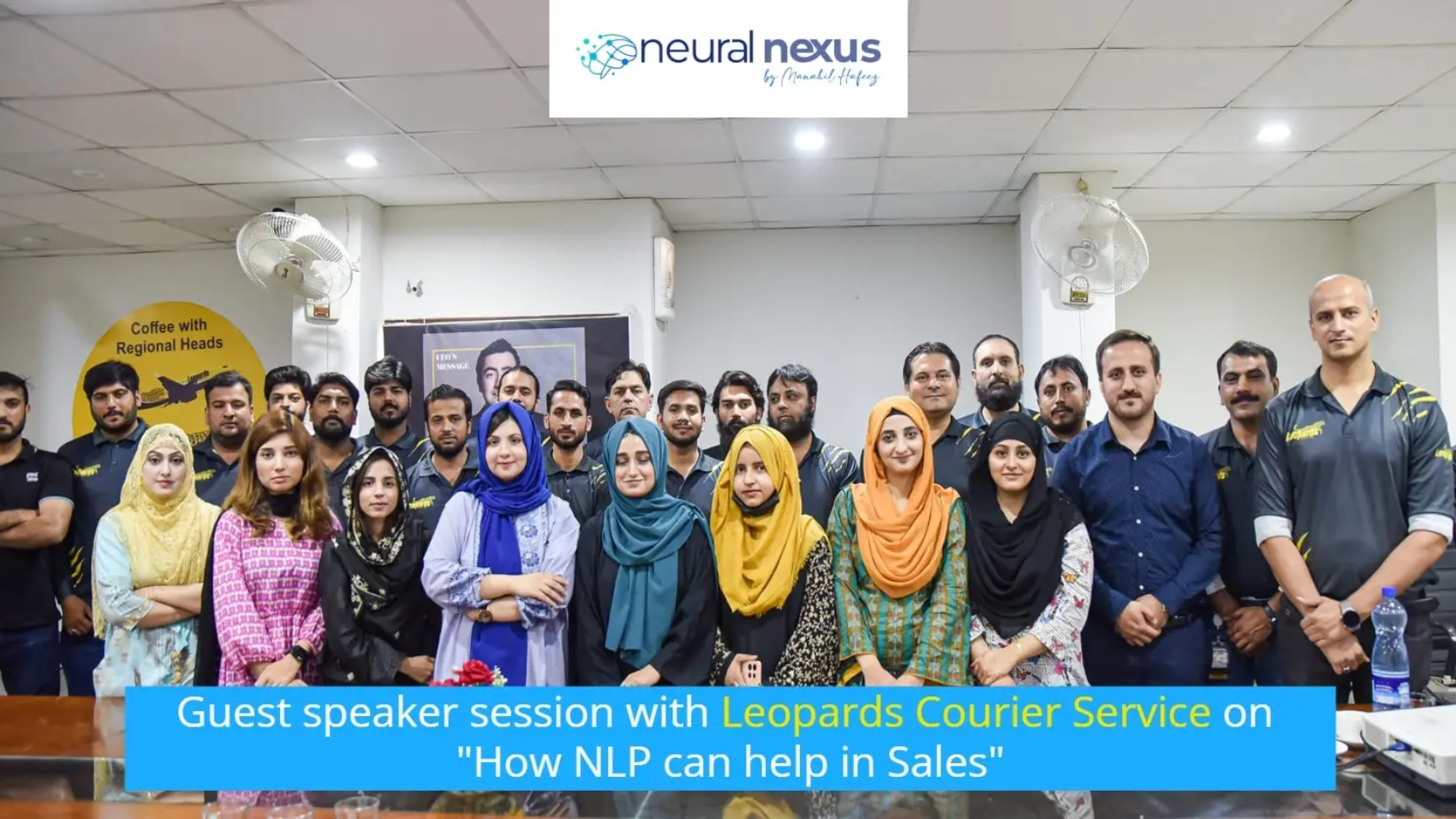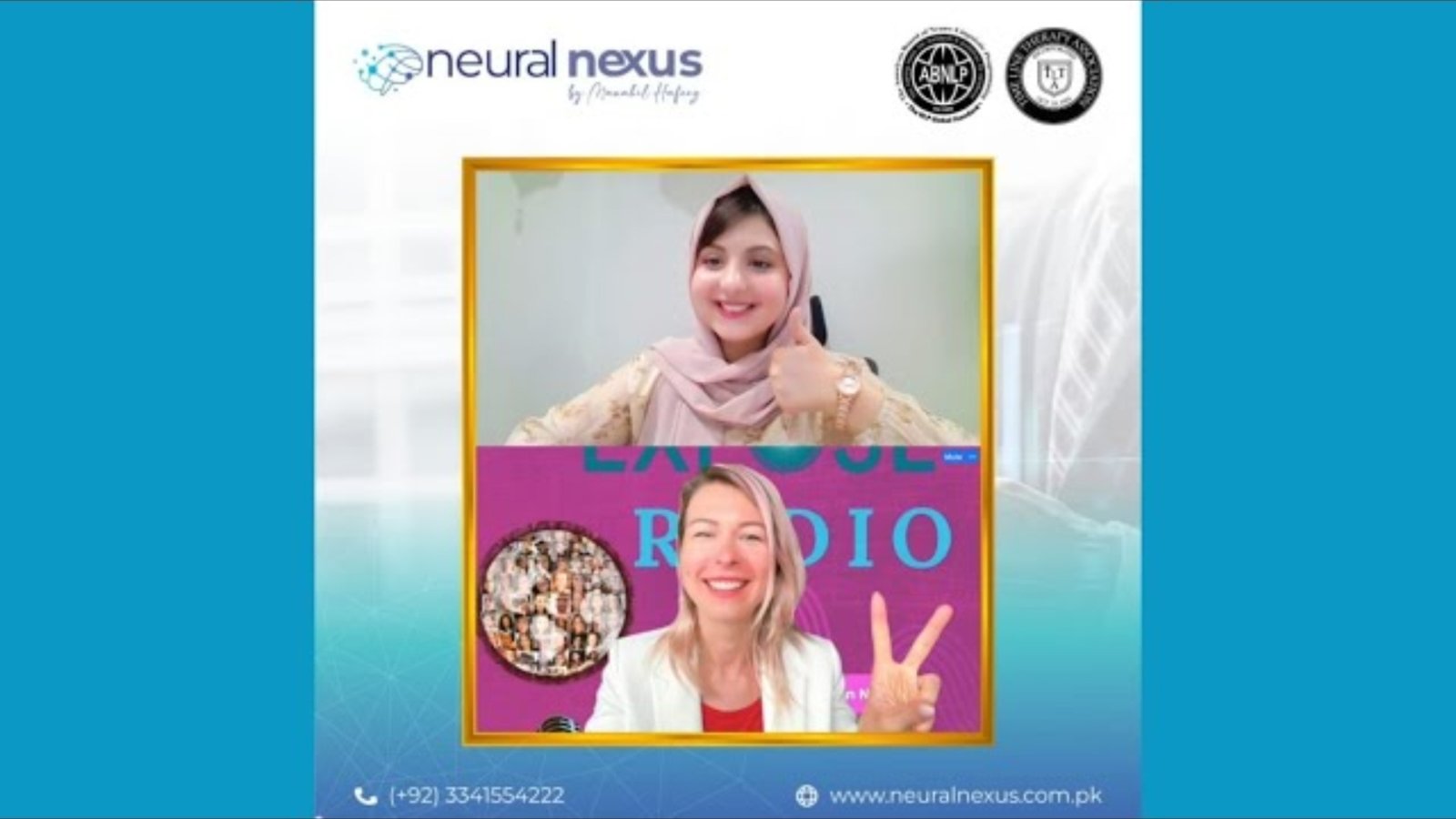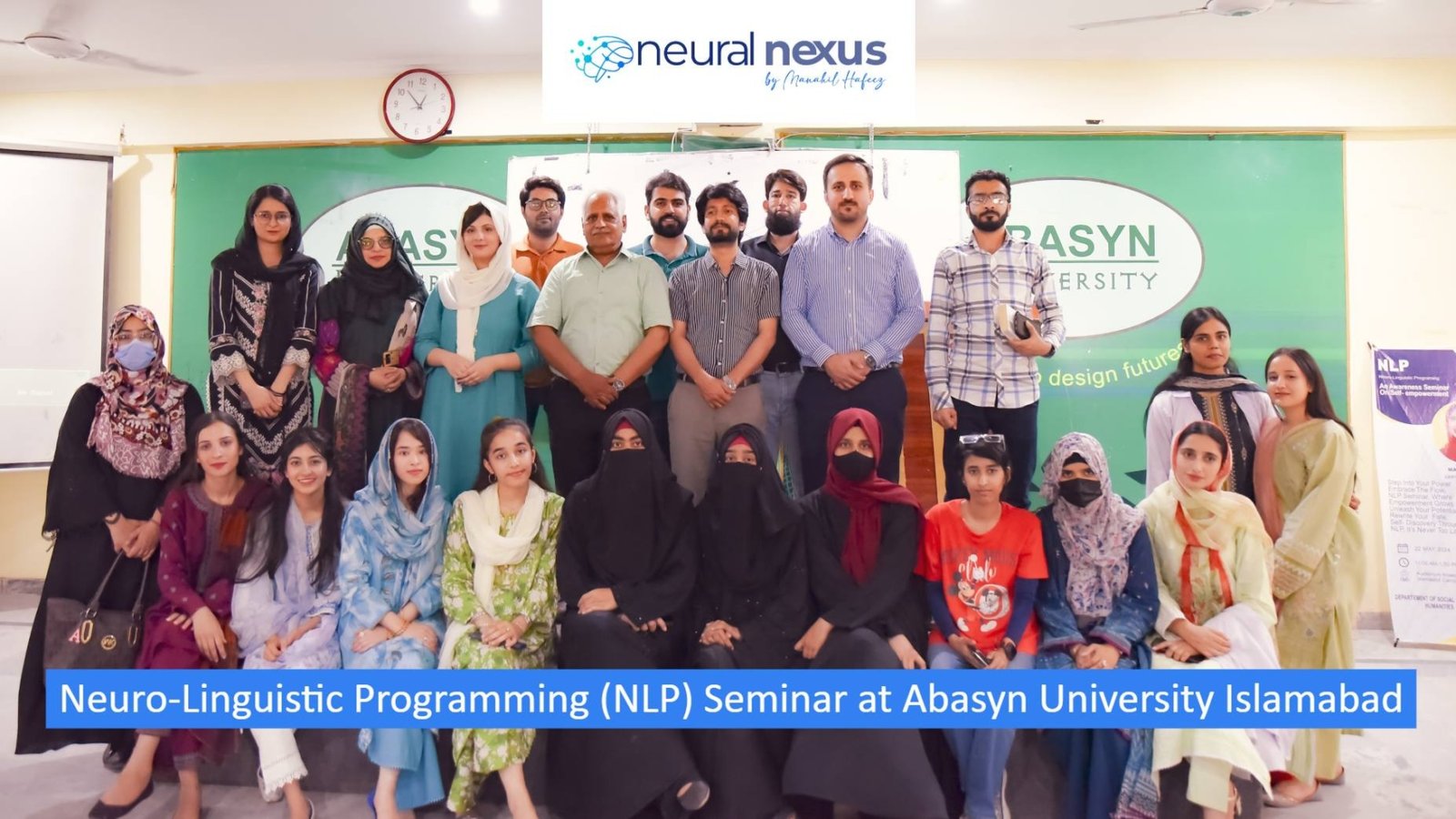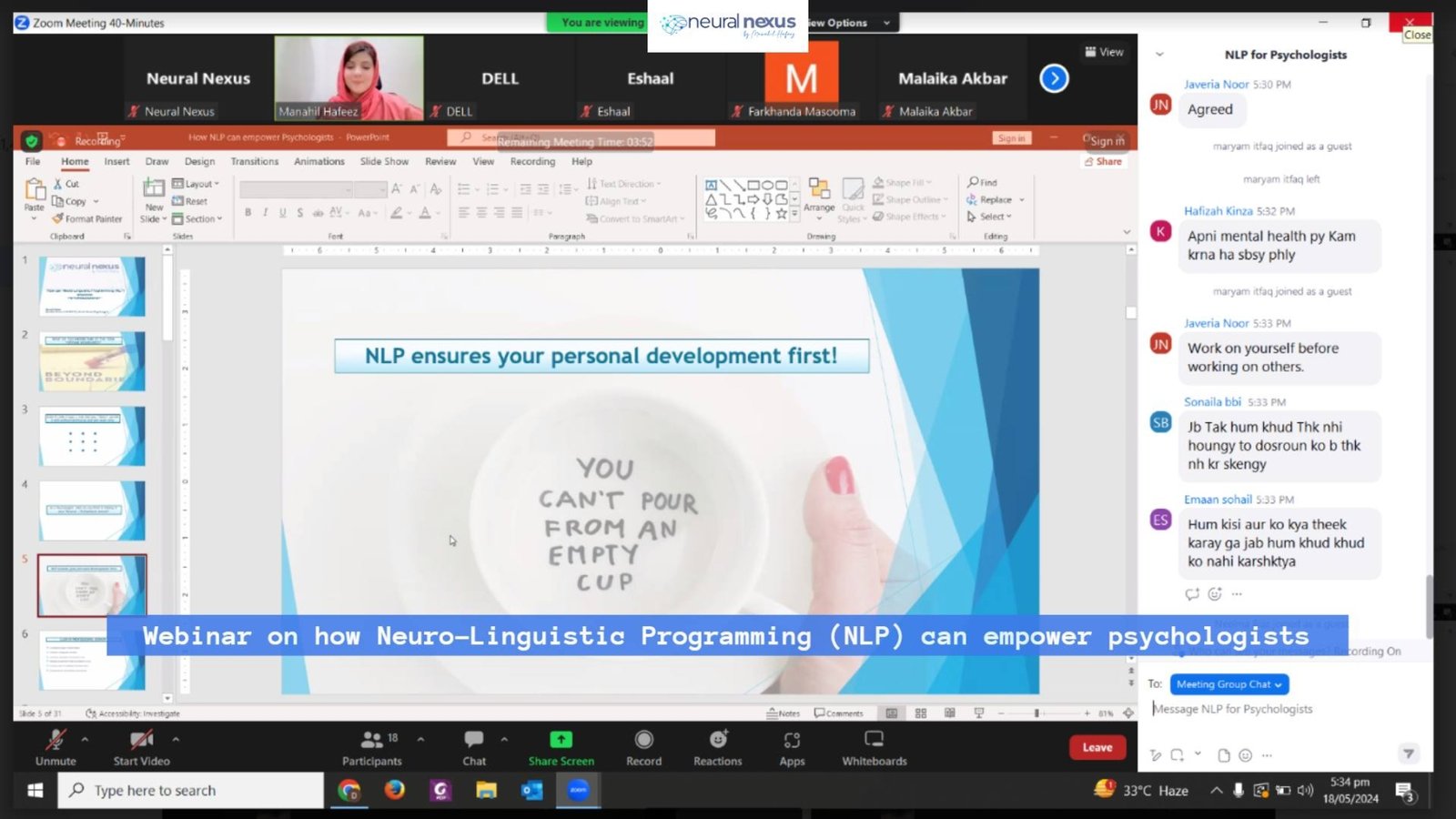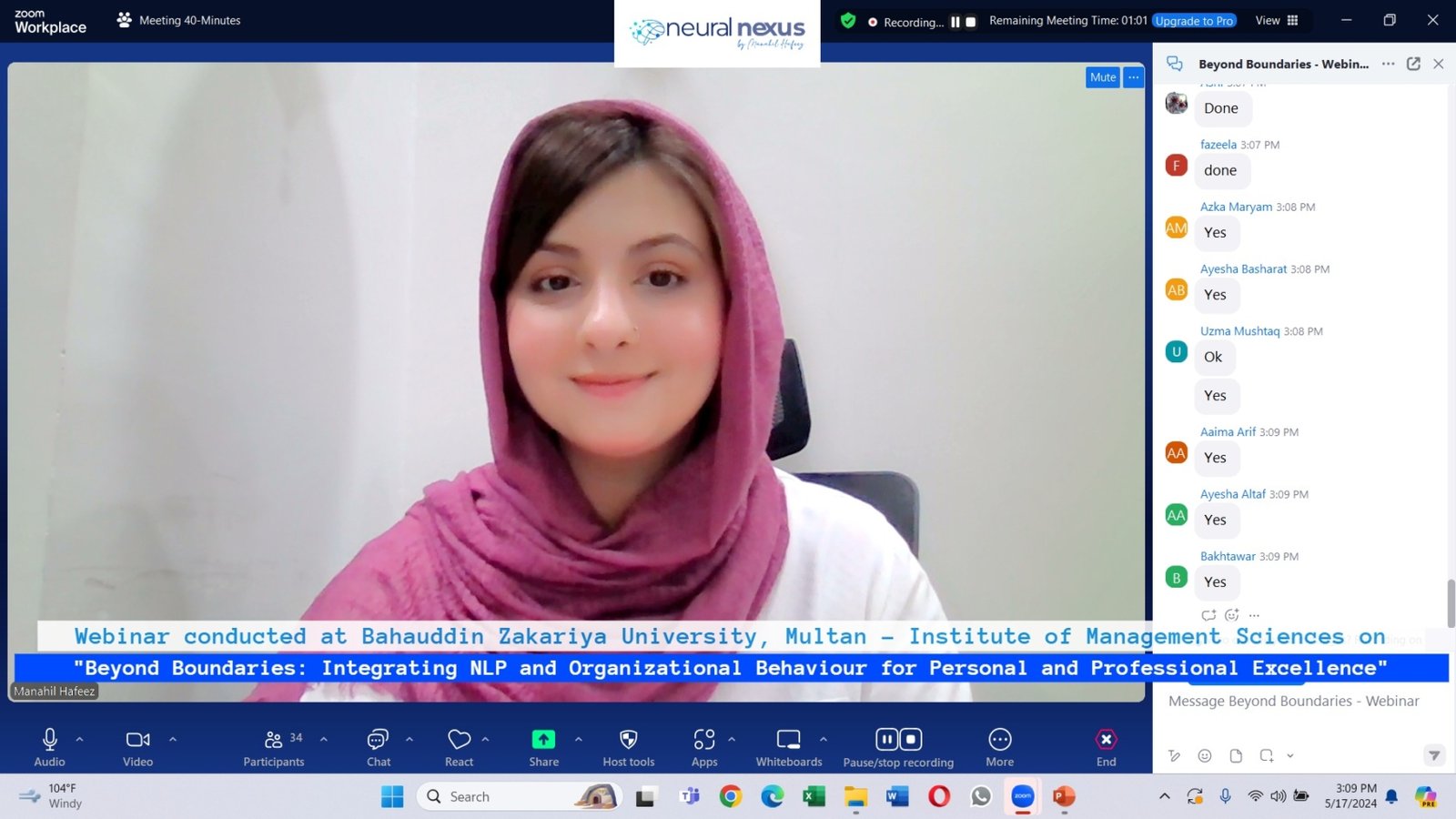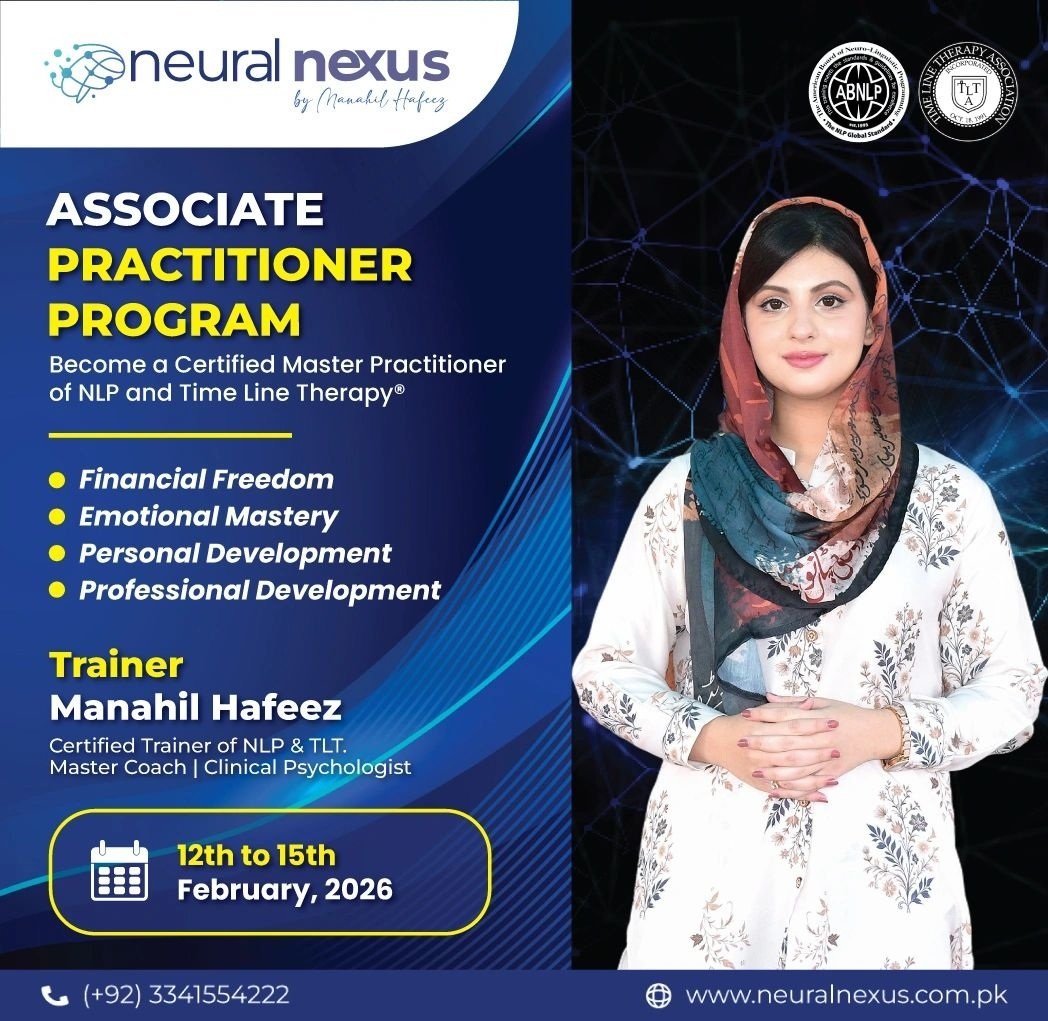🎥 Sharing the highlights from our insightful workshop on “Neuro-Linguistic Programming: The NLP Paradigm: Intersection of Language, Thought, and Behavior” at Rawalpindi Women University. Our amazing trainer, Manahil, delivered a powerful session, guiding participants through transformative techniques and practical applications. Her expertise and engaging style made the experience truly impactful!
Podcast Series on Neuro-Linguistic Programming
Episode 1: NLP – Debunking the Myths and Uncovering the Truth
Join us for an insightful conversation with our lead trainer Manahil Hafeez and June Acebedo, ABNLP Certified NLP Master Coach and Trainer in Hypnotherapy and Time Line Therapy® from Phillipines.
We’ll dive deep into common myths about NLP, including:
❌ *NLP is just manipulation* – The belief that NLP is used to control or deceive people.
❌ *NLP is a pseudoscience* – The misconception that NLP has no scientific basis or real-world application.
❌ *NLP is only for therapy* – The myth that NLP is limited to therapy and can’t be applied to business, coaching, or personal development.
❌ *NLP is outdated* – The idea that NLP techniques no longer hold value in today’s world.
❌ *NLP guarantees instant transformation* – The unrealistic expectation that NLP alone can change your life overnight.
❌ *NLP is incompatible with psychology* – The belief that NLP and psychology are at odds and cannot coexist.
In this episode, we will also explore the *rift between psychologists and NLP practitioners*, discussing:
🧠 The differing approaches of psychology and NLP
🧠 Why some psychologists remain skeptical of NLP
🧠 How NLP and traditional psychology can complement each other
🧠 Is there a future for integration between these fields?
📅 *Date:* 17th September 2024
✨ Tune in to hear leading NLP trainers debunk myths and discuss the ongoing debate with psychologists!
Guest speaker session with Leopards Courier Service on “How NLP can help in Sales”
How NLP can help in Sales?
Our trainer Manahil Hafeez Anjum has been invited as a guest speaker for an illuminating session on “Neuro-Linguistic Programming (NLP)” by the “Leopards Courier Service“. With her profound expertise and innovative approach to NLP, Ms Manahil has provided the employees with valuable insights and skills, helping them reach new heights of performance.
EXPOSE PODCAST by Anastajya – California L.A
Our trainer, Manahil Hafeez Anjum , was invited to a podcast hosted by Anastazja Gajkowska to talk about Neuro-Linguistic Programming (NLP) and its effect on our relationships with ourselves and others. This podcast is part of the second series by Expose Media & Video Production which features interviews with famous individuals. Manahil is the first person selected from Pakistan. Indeed it is an honour for us.
Youngest NLP Trainer in Pakistan, Manahil Hafeez Anjum, Shares Transformative Insights at Radio Pakistan
Radio Pakistan proudly arranged an enlightening guest speaker session featuring the youngest NLP (Neuro-Linguistic Programming) trainer in Pakistan!
Our esteemed trainer, Manahil Hafeez Anjum, invited specially for this event, shared profound insights into the ‘What, Why, and How of NLP’.
She captivated the audience with her inspiring journey and remarkable achievements, showcasing the transformative power and practical applications of NLP. We are incredibly proud of our trainer for achieving so much at such a young age. Her dedication and accomplishments are truly inspirational!🌟
Neuro-Linguistic Programming Seminar at Abasyn University Islamabad!
We are pleased to share the success of our recent seminar on Neuro-Linguistic Programming (NLP) at Abasyn University! Over 90 students from various departments participated in this enlightening event. The seminar covered the what, how, and why of NLP, featuring engaging presentations and interactive Q&A sessions. The enthusiasm and participation from the students made the event truly memorable. At the end of the seminar, our trainer, Manahil Hafeez Anjum was honored with a shield in recognition of the insights shared, by Prof. Dr. Raja Nasim Akhtar.
Participants delved into the fascinating world of NLP, exploring how language and behavior patterns shape our experiences and interactions. From powerful techniques for personal development to effective communication strategies, it was a day filled with enriching insights and growth.
A big thank you to everyone who made this seminar a success!
Webinar on how Neuro-Linguistic Programming (NLP) can empower Psychologists
Seminar on NLP at Foundation University School of Science & Technology – FUSST
Seminar on Neuro-Linguistic Programming (NLP)
Webinar conducted at IMS, BZU Multan
Webinar on “Beyond Boundaries: Integrating NLP and Organizational Behaviour for Personal and Professional Excellence”
How to Take Control of Your Thoughts and Emotions and Reprogram Your Mind
Introduction
We are so often victims of our own thoughts. With our minds racing all the time, very few of us experience the feelings we desire on a daily basis. We take a daily hit of coffee because we’re tired. We use sleeping pills to turn off the lights because we couldn’t stop that stupid machine at night. However, the truth is that we possess the power to take control of our thoughts and emotions. While it’s not an easy journey and requires dedicated practice, even small steps can lead to profound changes in our mental landscape.
Step 1: Begin with the ideas you wish to consider
Envision yourself in a dimly lit space, stumbling over the walls in search of a light switch. Do you pause to consider how you got in this room or try to figure out a map showing you where the light switch is? The answer is quite obvious. You locate the light switch and turn on the lights in the room.
Too many of us are eager to begin “fixing” things right away. We want to focus on the ideas we desire and dismantle the mental processes that keep us worried or up at night when we’d sleep better if we just stopped thinking about it.
Step 2: Establish the Habits of Your Ideal Self
While Step 1 may seem daunting, it sets the foundation for your journey towards reprogramming your mind. It requires resilience and dedication to repeatedly challenge and redirect your thoughts. Think of monks who devote their lives to cultivating a mindset free from worldly distractions. They surround themselves only with influences that reinforce their chosen way of thinking.
Now, envision the ideal version of yourself; the person who embodies the mindset you aspire to have. Whether it’s unwavering confidence, mindfulness, or inner peace, imagine how this version of yourself navigates daily life. How does this individual describe their day? How do they respond to fatigue or the urge to hit the snooze button in the morning? How do they handle unexpected disruptions like traffic jams? And how do they react when faced with conflict or confrontation at work?
By visualizing and embodying the habits and behaviors of your ideal self, you can begin to align your actions with your desired mindset, paving the way for lasting change and transformation.
Step 3: Commit to Your Deepest Desires
While reprogramming your mind may seem daunting, it’s the commitment to stay the course that truly defines the path to transformation. In the realm of psychology, it’s often said that “getting started is the hardest part,” but in reality, it’s the unwavering dedication that poses the greatest challenge.
Consider the influx of new faces at the gym every January, filled with aspirations of weight loss and self-improvement. Yet, as February rolls around, many have already abandoned their resolutions. This phenomenon is not unique to fitness goals; it echoes throughout various aspects of life. We encounter individuals who launch businesses only to let them stagnate, or who embark on new ventures only to find themselves back at square one.
The key lies not just in initiating change, but in sustaining it through unwavering commitment. By acknowledging and embracing your deepest desires, you can fuel your journey towards lasting transformation, refusing to be deterred by the inevitable challenges along the way. It’s this steadfast dedication that separates those who merely start from those who truly succeed in rewriting the script of their lives.
Step 4: Equip Yourself with Psychological Tools
Just as different vehicles require specific tools for maintenance, our minds too demand tailored strategies for proper functioning. What motivates and challenges one person may differ from another, making it essential to identify personalized techniques to navigate life’s hurdles.
In response to this need, we’ve developed a tool called “The Cure”; a four-step process designed to recalibrate your neurology:
- Smile: Even a forced smile signals to your brain that it’s permissible to experience joy, activating neural pathways associated with positivity.
- Stretch: Elevating your arms overhead or engaging in any sudden movement can alleviate tension, boost circulation, and reorient your focus to the present moment.
- Chant a Mantra: Vocalizing simple affirmations like “Yes!” or “I’ve got this!” can counteract negative self-talk by overshadowing limiting beliefs with empowering assertions.
- Deep Exhalation: Release pent-up tension by exhaling deeply, allowing your body to relax and restoring a sense of calm.
By incorporating these tools into your daily routine, you can proactively manage your thoughts and emotions, empowering yourself to navigate challenges with resilience and clarity. Remember, the key to psychological well-being lies not only in understanding your mind but also in equipping yourself with the tools to harness its full potential.
Conclusion
Within each of us lies the power to take control, to rewrite the script of our inner narrative, and to reprogram our minds for greater peace and fulfillment. Through the exploration of techniques such as positive reframing, visualization, and mindfulness, we gain insight into the inner workings of our psyche. Armed with this understanding, we embark on a journey of self-discovery and transformation.
As we cultivate habits aligned with our ideal selves and commit to our deepest desires, we harness the power of our minds to shape our reality. With each smile, each mantra, each deep breath, we assert our sovereignty over our thoughts and emotions. Let us live empowered by the knowledge that within us lies the ability to take control of our thoughts and emotions, and to reprogram our minds for a life of purpose, joy, and fulfillment.
FAQs
Q1. How can I manage my thoughts and feelings?
Mastering control over your thoughts involves several strategies:
- Recognize the connection between your mind and body.
- Accept the present moment.
- Redirect your focus to positive aspects.
- Engage in mindfulness practices such as meditation, priming, or visualization.
- Identify and challenge limiting beliefs.
Q2. Can I have control over my thoughts?
While you may not have control over every thought that arises, you can modify active thought patterns and choose how to respond to them. By directing your attention and consciously selecting which thoughts to focus on, you can influence your actions and emotional responses.
Q3. Why am I unable to master my thoughts?
Difficulty in mastering thoughts is often linked to anxiety, which can lead to negative thinking patterns. Anxiety disorders can impair cognitive functioning and make it challenging to regulate thoughts and emotions effectively.
Q4. How may NLP be used to achieve your goals?
Neuro-Linguistic Programming (NLP) offers various techniques to reshape behavior and thought patterns. Strategies like reframing negative thoughts, visualizing success, and modeling successful behaviors can aid in goal achievement. Clear goal setting is essential for effective planning and maintaining focus.
Q5. Can NLP be used to perform manipulation?
NLP is one of the widely used techniques for mind control and manipulation, alongside other methods like targeted deception. It’s employed by various individuals and groups, including politicians, media personalities, and sales professionals, to influence behavior and perceptions.



